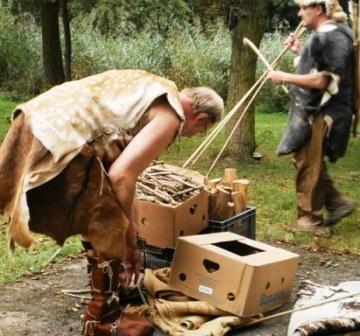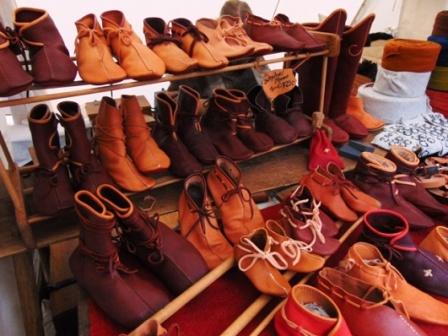You can make a simple shoe with a sturdy patch leather. Draw the shape of your foot on the rag. Make that around 2 centimeters larger. As wide as your hand, you let a piece of leather on the left, right and back. Front may be double that long. The rest you cut off. Fold back and sides up. Sew them together on the back. The front flap you fold over your foot. She is even nowadays often still seen as the tongue of the shoe. In the front sides on the arch you make holes (eyelets, see buttonhole) where you can string laces through.
 With trial and error you can cut better and more appropriate models.
With trial and error you can cut better and more appropriate models.
Even better, with less cutting and less leather waste, it is if you take for tongue, sole and back one narrow strip of leather, and a second wider on the sides and sole (again). Then you have an instant solid double sole. That you can glue and sew.
If you make the leather wet, and let dry on your feet, the shoe will keep its shape (until it gets wet again).
Shoes can also be woven or braided with (birch) bark . The Russian 'lapot” means shoe from tree bark.
Making shoes or stockings may also with an easy pattern of square patches.
https://www.youtube.com/watch?v=3JCpMpmcz34 How to assembly slippers with squares after a chart
Before 1850 there were no left and right shoes, both versions were identical. After sandals and foot- and leg wraps, attempts were made to attach soles to side flaps using traditional methods. When Jan Ernest Matzeliger (Suriname) was able to do this mechanically, it became possible and affordable to make left and right shoes different.
Indians in the Amazon made the first "rubber" boots by standing up to their knees in latex and allowing them to dry. They did not appear in Europe until 1851 (after the addition of sulfur in 1839 by Charles Goodyear).
The Belgian designer Mats Rombaut designed shoes for vegetarians from bark of the fig tree, sustainably harvested in Uganda. The tree tanners knock the wet bark with wooden balls so that there arises a large rag of tree leather. The method has been around since prehistoric times, and has been declared by UNESCO to protected cultural heritage.
I 've once cut soles from the tread of a tire to repair worn shoes. Accounting for more than 80,000 km. But horribly heavy.
If you attached the sole with ropes or straps to your foot that makes it a sandal.
If you let the sides run higher and sew them together, you get a boot.
Soles you can also make more durable by striking (many) nails with broad heads.
You can make them waterproof with pitch. The side and top with wax or polish.
"What would you do if you walked in my shoes? '' Buy new!”(JA Deelder)
Polish
 Shoe polish is a kind of shoes wax to maintain shoes and others leather products. By using shoe polish the shoe leather will not dry out and its life extends. Apply the cream to the clean and dry leather. Leave on for a short time, and rub it with a cloth so that it will shine.
Shoe polish is a kind of shoes wax to maintain shoes and others leather products. By using shoe polish the shoe leather will not dry out and its life extends. Apply the cream to the clean and dry leather. Leave on for a short time, and rub it with a cloth so that it will shine.
Black shoe polish you can make:
whisk an egg and add 1 tablespoon vinegar, 2 tablespoons of beer and 1 scoop soot to it. Mix well. Possibly add a few drops of coffee in order to give the shoe cream extra shine .
Or take a third vegetable oil, a third vinegar and a third apple butter. For black grease add some soot.
Or use beeswax. By rubbing it becomes warm and will penetrate into the leather. Oil and grease can also be used.
"The first days the shoes will still pinch a little.”"Never mind, I‘ll wear them next week!”(JW Besouw)
Skating and skiing
As early as 3,000 BC, the Finns tied trough a modified bone with leather straps bone skating under their shoes. They were used to walk on the ice of frozen lakes with a type of (ski) poles.
In the same period in Lapland and Sweden wooden skis were used, twice as wide as the current one. (In Kalvträsk they found one of 204 x 15.5 cm.)
Snowshoes were a kind of woven tennis rackets to bind under snow boots They increase the fulcrum so that you do not sink (so deep) into the snow. That makes walking on (instead of in) the snow less strenuous.
Why have shoes a heel?
Increased soles were by Greeks (cothurni) and Romans used to make appear Gods figures higher on the scene.
A separate heel would come later to prevent riders (knights) would slide with their feet trough the stirrup when mounting their horses. The rear part of the sole does not need flexibility.
In our steps and walk the heel should absorb a lot of pressure. A heel can absorb shock.
Around 1660 the men wore at court (red) high heels as a status symbol: you cannot do any work, so it was a sign of luxury and wealth. Louis XIV also used this costume to look bigger. A higher heel was a higher status. The word stumbling blockwould find its origin there.
Because we find it sexy many ladies buy unhealthy high heels which they can hardly walk. High is 7-8 cm. But 12-13 is available. Or extreme. The toll for a tempting mockery with the buttocks to the back and the breasts forward can lead to shortened calf muscle, cramps, hollow back, cartilage wear and low back pain, risk of falls and sprains.
Very elegant and beautiful, but in moderation. Not suitable for 24/7.
